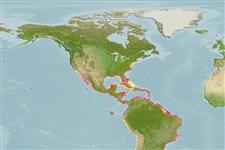Common names from other countries
>
Eupercaria/misc (Various families in series Eupercaria) >
Gerreidae (Mojarras)
Etymology: Eucinostomus: Greek, eu = good + Greek, kyon = dog + Greek, stoma = mouth (Ref. 45335).
More on authors: Baird & Girard.
Environment: milieu / climate zone / depth range / distribution range
Ecologie
marien; zoet water; brak water rifbewoner; diepte 0 - 12 m (Ref. 5227). Subtropical; 41°N - 30°S, 120°W - 34°W
Eastern Pacific: Anaheim Bay in southern California, USA southward to Peru, including the Galapagos Islands. Western Atlantic: New Jersey, USA and Bermuda through the Gulf of Mexico and the Caribbean to southeastern Brazil (Ref. 7251).
Lengte bij maturiteit / Grootte / Gewicht / Leeftijd
Maturity: Lm 12.8 range ? - ? cm
Max length : 21.2 cm TL mannelijk / geslacht onbekend; (Ref. 102462); common length : 15.0 cm TL mannelijk / geslacht onbekend; (Ref. 3722); max. gepubliceerd gewicht: 119.66 g (Ref. 102462)
Dorsale stekels (totaal) : 9; Dorsale zachte stralen (totaal) : 10; Anale stekels: 3; Anale zachte stralen: 8. Tip of dorsal fin dusky. Premaxillary groove continuous but narrow, bordered by scales anteriorly (Ref. 26938).
Found over soft bottoms of bays and shallow inshore areas, often along sand beaches (Ref. 2850). Enters freshwater (Ref. 7251). Juveniles are encountered in lagoons of mangroves. Omnivorous (Ref. 9303). Marketed fresh but not highly esteemed; processed into fish meal and used as live bait in the snapper fishery (Ref. 3722).
Levenscyclus en paargedrag
Maturities | Voortplanting | Spawnings | Egg(s) | Fecundities | Larven
Eschmeyer, W.N., E.S. Herald and H. Hammann, 1983. A field guide to Pacific coast fishes of North America. Boston (MA, USA): Houghton Mifflin Company. xii+336 p. (Ref. 2850)
Status op de Rode Lijst van het IUCN (Ref. 130435)
CITES (Ref. 128078)
Not Evaluated
Gevaar voor de mens
Harmless
Gebruik door de mens
Visserij: van minder commercieel belang; aas: occasionally
Tools
Speciale rapporten
Download XML
Internetbronnen
Estimates based on models
Preferred temperature (Ref.
115969): 20.6 - 28.3, mean 27 (based on 1053 cells).
Fylogenetische diversiteitsindex (Ref.
82804): PD
50 = 0.5010 [Uniqueness, from 0.5 = low to 2.0 = high].
Bayesian length-weight: a=0.00977 (0.00825 - 0.01157), b=3.08 (3.04 - 3.12), in cm Total Length, based on LWR estimates for this species (Ref.
93245).
Trofisch niveau (Ref.
69278): 3.2 ±0.1 se; based on diet studies.
Weerstandsvermogen (Ref.
120179): Hoog, minimale populatieverdubbelingstijd minder dan 15 maanden (Preliminary K or Fecundity.).
Fishing Vulnerability (Ref.
59153): Low to moderate vulnerability (25 of 100).
